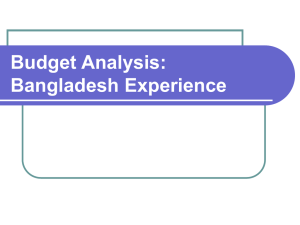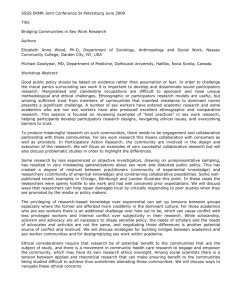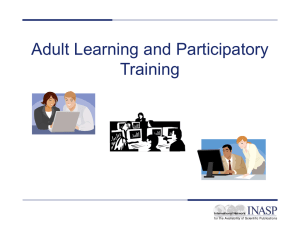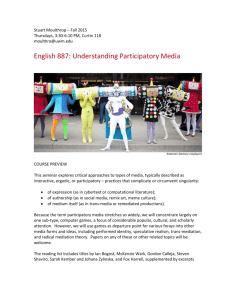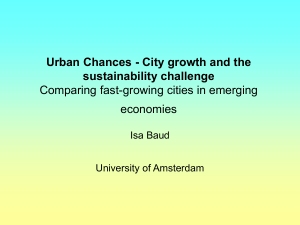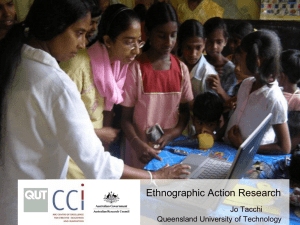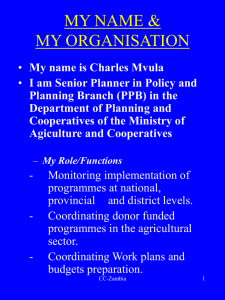Brainstorm document – PROLINNOVA curriculum development
advertisement
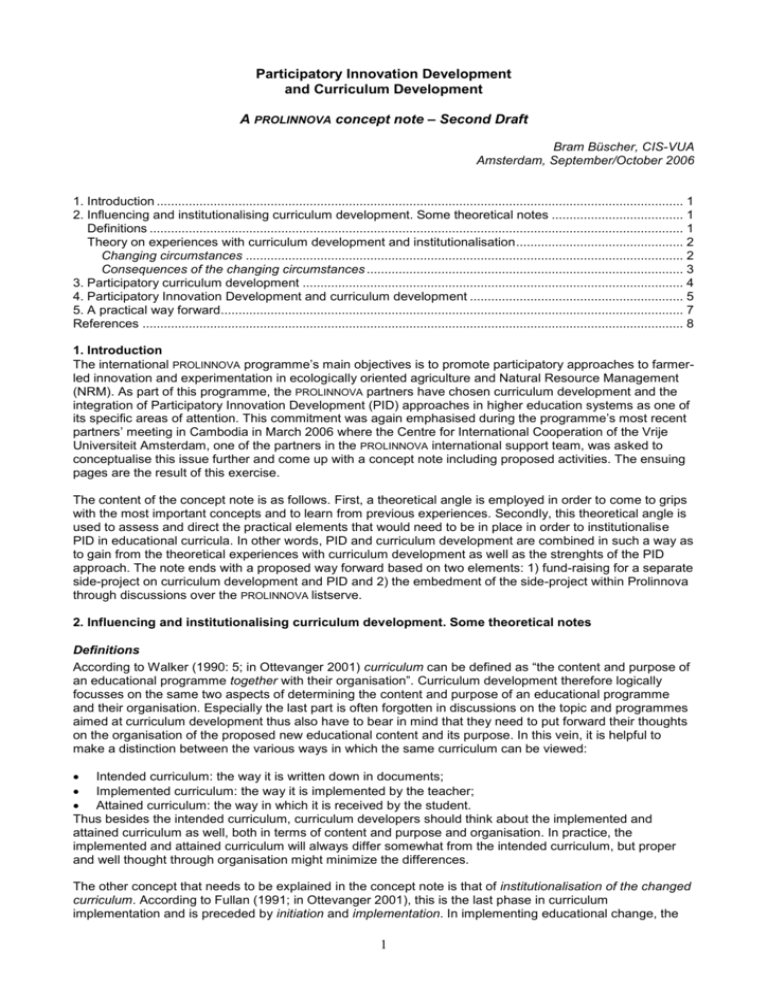
Participatory Innovation Development and Curriculum Development A PROLINNOVA concept note – Second Draft Bram Büscher, CIS-VUA Amsterdam, September/October 2006 1. Introduction .................................................................................................................................................... 1 2. Influencing and institutionalising curriculum development. Some theoretical notes ..................................... 1 Definitions ...................................................................................................................................................... 1 Theory on experiences with curriculum development and institutionalisation ............................................... 2 Changing circumstances ........................................................................................................................... 2 Consequences of the changing circumstances ......................................................................................... 3 3. Participatory curriculum development ........................................................................................................... 4 4. Participatory Innovation Development and curriculum development ............................................................ 5 5. A practical way forward.................................................................................................................................. 7 References ........................................................................................................................................................ 8 1. Introduction The international PROLINNOVA programme’s main objectives is to promote participatory approaches to farmerled innovation and experimentation in ecologically oriented agriculture and Natural Resource Management (NRM). As part of this programme, the PROLINNOVA partners have chosen curriculum development and the integration of Participatory Innovation Development (PID) approaches in higher education systems as one of its specific areas of attention. This commitment was again emphasised during the programme’s most recent partners’ meeting in Cambodia in March 2006 where the Centre for International Cooperation of the Vrije Universiteit Amsterdam, one of the partners in the PROLINNOVA international support team, was asked to conceptualise this issue further and come up with a concept note including proposed activities. The ensuing pages are the result of this exercise. The content of the concept note is as follows. First, a theoretical angle is employed in order to come to grips with the most important concepts and to learn from previous experiences. Secondly, this theoretical angle is used to assess and direct the practical elements that would need to be in place in order to institutionalise PID in educational curricula. In other words, PID and curriculum development are combined in such a way as to gain from the theoretical experiences with curriculum development as well as the strenghts of the PID approach. The note ends with a proposed way forward based on two elements: 1) fund-raising for a separate side-project on curriculum development and PID and 2) the embedment of the side-project within Prolinnova through discussions over the PROLINNOVA listserve. 2. Influencing and institutionalising curriculum development. Some theoretical notes Definitions According to Walker (1990: 5; in Ottevanger 2001) curriculum can be defined as “the content and purpose of an educational programme together with their organisation”. Curriculum development therefore logically focusses on the same two aspects of determining the content and purpose of an educational programme and their organisation. Especially the last part is often forgotten in discussions on the topic and programmes aimed at curriculum development thus also have to bear in mind that they need to put forward their thoughts on the organisation of the proposed new educational content and its purpose. In this vein, it is helpful to make a distinction between the various ways in which the same curriculum can be viewed: Intended curriculum: the way it is written down in documents; Implemented curriculum: the way it is implemented by the teacher; Attained curriculum: the way in which it is received by the student. Thus besides the intended curriculum, curriculum developers should think about the implemented and attained curriculum as well, both in terms of content and purpose and organisation. In practice, the implemented and attained curriculum will always differ somewhat from the intended curriculum, but proper and well thought through organisation might minimize the differences. The other concept that needs to be explained in the concept note is that of institutionalisation of the changed curriculum. According to Fullan (1991; in Ottevanger 2001), this is the last phase in curriculum implementation and is preceded by initiation and implementation. In implementing educational change, the 1 initiation phase is where the decision is made whether to go ahead with development and implementation of a new curriculum or not. According to Ottevanger (2001: 33): “change programmes are often initiated centrally, driven by political factors, and by external agencies, especially if these agencies also provide funding for such change programmes.” The second phase of curriculum implementation according to Fullan is the actual implementation itself: putting into practice the envisaged change. Only after this phase comes continuation or institutionalisation, which means that the change becomes standard practice in that specific institute. This, however, is a rather formal conceptualisation of the institutionalisation process. Another definition of institution, one that is more common in political science, is that the concept entails both formal and informal ‘ways of doing things’ in a more or less structured organisational context. This extended definition confronts the reader with other, less graspable, issues but ones which are nonetheless very important to think about when starting curriculum implementation: intercultural communication, organisation cultures, leadership in organisations, etc. Organisations hereby are then meant as educational institutes, whereby one has to ex ante be aware that these issues always differ per institute and take a while to comprehend in their local context. ‘Curriculum implementation and institutionalisation’ are therefore not to be thought of too lightly! These definitions are of course rather ‘sterile’ still, and they have to be understood in a context. We therefore turn to discuss the above concepts in the light of previous experiences of where and how they have been applied, especially in relation to the issue of change being initiated externally. Theory on experiences with curriculum development and institutionalisation Literature on curriculum development and instutitionalisation is extensive and could never be adequately covered in a short concept note. Hence, in order to narrow down the scope of the literature search, we looked foremostly on theory describing experiences with curriculum development in developing countries as this is where PROLINNOVA also focusses on - and within the thematic areas of agriculture and Natural Resource Management. Changing circumstances A first important general point stressed in the literature is about the fast changing context(s) in which agricultural education now finds itself. According to Wallace, the two most important changes have to deal with how agriculture is currently being looked at and how the traditional concepts of teaching and learning are changing rapidly. With respect to the first, Wallace states that a systems view has come up over the past decades which highlights “interrelationships and linkages within broader agricultural knowledge and Information systems, which are perhaps better termed ‘rural development systems’ (Wallace, 1997: 28). Moreover, Wallace asserts that “‘Agriculture’ itself is becoming an obsolete term, as the interest in Farming Systems Research and Development leads to broader concepts of the management of Renewable Natural Resources, which include notions of sustainable (or Low External Input) agriculture, social (or rural development) forestry, aquaculture and small-scale fisheries, wildlife conservation and management” (Idem: 28). This last trend is well illustrated by the PROLINNOVA programme itself, as its subtitle reads: ‘PROmoting Local INNOVAtion in ecologically-oriented agriculture and natural resource management’. The second important changing circumstance has to do with the nature of teaching and learning in the field of agriculture and NRM. According to Wallace, this has to do with trends such as ‘soft-systems thinking’, ‘farmer-first approaches’, “the growth of interest in Indigenous Technical Knowledge” and the idea of ‘learning organisations’ (Idem). Again, the PROLINNOVA programme illustrates these changes well. These changing circumstances have lead to a divide in educational ideologies (or educational philosophies) in which two major contrasting frameworks can be identified: the classical and the participatory models (Van Crowder, 1997). The classical top-down model of curriculum development is mostly led by ‘experts’ who believe they have the technical knowledge to device, develop and implement relevant and objective curricula. Also called the ‘rationalist’ approach to curriculum development, it is product oriented and assumes that there is a consensus on education objectives, goals and outcomes (Idem). The participatory approach, in contrast, departs from completely opposite assumptions. It views curricula as subjective and puts more emphasis on the learning process, rather than the outcome. The participatory approach moreover believes that the combined knowledge and experiences of professionals and the learners themselves should determine the curriculum content in a dynamic way, leading to interactive learning processes. In many developing countries and especially in Africa, much of the literature agrees that there has been a shift in thinking from the classical to the participatory approach, a shift which reflects thinking in development more general. In practice, however, current curricula in developing countries are judged to be somewhere in between these two opposites, whereby adherence to the classical model still seems to be dominant (Taylor, 1999). It seems straightforward then to conclude that participatory approaches must be further strengthened and developed, but some degree of caution is important here. Although favouring the participatory approach 2 himself, Van Crowder rightly emphasises that the choice between the models is a difficult one, as two opposing general trends continue to influence the curriculum development process. These are globalisation on the one hand, and localisation on the other. The first exerts pressures of standardisation so as to facilitate international connections and exchanges, which has as a consequence the formalisation of education resembling the classical model. The second pressure of localisation entails decentralisation of authority and decision-making in curriculum development to lower scale educational units including the active role that local actors play. This trend fits in neatly with the participatory approach to curriculum development. It is with these changing circumstances and opposing pressures in mind that all actors aiming to be involved in curriculum development must very consciously and cautiously reflect on the ‘why’ of their involvement and on how and where this involvement should be organised and implemented. In doing this, it is vital to take into account the consequences of the above described changes and pressures so as to distill ingredients for involvement that are most likely to lead to positive effects. Consequences of the changing circumstances Wallace (1997) distinguishes between nine consequences of the above described changing circumstances or current dilemmas facing agricultural education and training1. The first is changing patterns of support and provision. Wallace points here at the complex infrastructure of actors already involved in agricultural education in Africa and how these have influenced and shaped the field. He concludes that under the pressure of structural adjustment programmes, public sectors have shrunk considerably, whereas there has continued to be a steady supply of graduates suitable for work in government. Educational institutes must therefore rethink and redirect their curricula to make graduates more suitable to the private sector. In addition, other involved actors must also think about their role in supporting curriculum development and align these with changing circumstances. Although Wallace does not explicitly delve into the issue of governance, with this point he does hint at it so close as to warrant a further remark. In governance studies, there is now a general consensus that a shift has occurred in the last 16 years from a focus on government to governance (Rosenau, 1997). To some this might sound trivial but the implications have been far reaching. Whereas the primacy of developing policies, implementing change and issueing directives used to lie foremostly with national governments, it is now agreed that a multitude of actors perform these roles within the public sphere, including NGOs, (expert) networks, powerful individuals, private companies, local communities, etc. Most of these are not directly democratically elected and therefore their accountability structures are often vague, if present at all. This makes the governing of educational change and development much more difficult and complex. The more actors on the scene, the more complex structures become and therefore also the ability to manage changing circumstances and dealing with the above described pressures. One consequence of this governance trend is that actors themselves must be much more conscious about their ‘added value’ and whether they are not complicating issues more than they are solving. How this relates to the responsibility of PROLINNOVA partners will be further elaborated below. The second issue mentioned by Wallace is emerging training needs. Whereas the first point emphasised the supply side of curriculum development, the demand side is also affected by the changing circumstances. As Wallace puts it: “In higher- and middle-level institutions, many students now face uncertain career pathways, which will often mean moving out of traditional ‘product-oriented’ agriculture into more managerial entrepreneurial or non-agricultural occupations” (Wallace, 1997: 31). As stated before, the agricultural field has broadened considerably and this impacts also on the career paths of graduates and therefore necessarily influences curriculum development as well. Following from this is the third dilemma, namely that the knowledge about these new training needs is often still lacking. In many countries, labour market studies are either lacking or misguided and this severely hampers the development of quality information needed for curriculum development. As such, the fourth issue, that of the continuous reliance on old models of curriculum development, does not alleviate the problem of new knowledge either. Many actors wanting to do ‘something about the spreading of certain agricultural knowledge systems or ideas’ come up with the idea of curriculum development, without knowing much about it. They then often rely on ‘tried and trusted’ models, which might not be applicable anymore. Again, this is a warning for caution to which will come back later. 1 Wallace specifically focussed on Sub-Sahara Africa, but many of his findings also seem applicable for many other developing countries. 3 A fifth dilemma is that of the need for staff development. Staff development in educational or training institutes in developing countries faces many urgent problems, among them a reliance on ‘bureaucratic’ adhoc recruitment instead of selecting on quality; low capacity; more focus on research than on teaching skills and little means for staff to further develop themselves in cooperation with their own environment (local communities, etc.). In order to handle the changes and pressures decribed above, investment in staff development is therefore a very urgent issue. Another, sixth dilemma comprises problems with donor support. Although familiar to most, problems such as donor dependency, no coordination between donors, overt focus on the project cycle and support for the status quo rather than for change remain imperative. Seventh, Wallace names inflexible systems and lack of linkages. Despite fast changing circumstances, educational systems, in line with the classical education model, often remain build around ‘etablished patterns and formal institutions’, with a lack of linkages between the many different actors that have arisen in the last decades. The consequence of this is a lack of dynamism so needed in the current international and many local contexts. The eight dilemma reads the lack of strategic planning and management skills. In order to tackle the above mentioned challenges, strategic planning and management skills are crucial and especially so on the level of the education and training institutes themselves. The idea that a general consensus between all involved actors in the field could emerge is a fallacy (Rosenau, 1997) and therefore management and leadership skills should be stimulated there where they are most needed. Lastly, Wallace mentions the need for a coherent policy framework, although this author is not sure whether investing too much money and energy in this will make any difference. Sure, coordination between various involved ministries (education, agriculture, economic affairs, etc.) should be enhanced within countries, but with all the pressures and changes outlined above, the search for one coherent policy framework, at whatever scale, is a fallacy and the search for it should therefore be avoided. Rather, managers, staff and other people at key position should be equiped with skills to deal with outside policy incoherency, so as to create most chances for them to stimulate as coherent as possible internal curricula without losing the dynamism so needed and demanded in these times. 3. Participatory curriculum development So, having said all this, what seems to be contemporary consensus on guaranteeing and institutionalising appropriate development of curricula in developing countries? Within the Centre for International Cooperation of the Vrije Universiteit Amsterdam (one of the PROLINNOVA partners), there is one section specialised in educational development. In discussion with two staff members (Ir. Rob Merkus and Dr. Wout Ottevanger), three general principles arose that should always be kept in mind. These are: Curriculum development should always be demand-driven, not externally imposed; Curricula should always be relevant to the environment and circumstances of the students; Curricula are always evolving. However, managing change must always be such that evolution of curricula is allowed, without it being unmanageable or confusing to the students. These principles fit in well with those from the literature on the topic. Naturally considering the participatory nature of the PROLINNOVA programme, these will hinge closely on the participatory approach to curriculum development, but with the remarks on the difficulty of choosing between the models in the back of our mind. Possibly the clearest information guides on what has been termed ‘Participatory Curriculum Development’ (PCD) in developing countries have been developed by the Food and Agriculture Organisation of the United Nations (Van Crowder, 1997; Rogers and Taylor, 1998; Taylor 1999). According to Van Crowder (1997: 3), PCD “recognises that there are philosophical frameworks and internal and external demands that influence the curriculum development process. It attempts to define the prevailing framework and indentify the demands in order to be cognizant of their impact on the process. Consistency is sought between internal and external demands in the final product”. What are then the more important elements of PCD? PCD entails (Van Crowder, 1997; Rogers and Taylor, 1998; Taylor 1999): Participation: the start of the curriculum process indentifies stakeholders, tries to bring them together and involve them throughout the curriculum process. PCD should thus be inherently unhierarchal and nonexclusive; Being systematic: without being overtly rigid, it relies on strategic and systematic planning by phasing the curriculum development process in a logical way; 4 Relevancy to local / regional development: despite continuous globalisation pressures, local and regional development issues must always be included in curricula, in order to be relevant to students; Curriculum-led change: it is dynamic and change oriented, therefore focusses much more on the learning process than on the actual content which can continuously change in response to changing circumstances. Although the above principles and elements of participatory curriculum development already offer several levers and guidelines for action, several more practical ideas can also be found in the literature. Madison Seymour (1991) for instance suggests that interuniversity linkages2 are appropriate for stimulating agricultural development in developing countries. She defines linkages as ‘planned institutional cooperation’ which include “direct operational ties, arrived at through mutual agreement, providing mutual benefit, and requiring mutual investment of resources”. The linkage and network among the PROLINNOVA approach has very similar features and it therefore seems worthwhile focussing further on this issue in the next section. Madison Seymour does however give several guidelines for effective interuniversity linkages for agricultural development, namely: Continuity: commitment between the parties must be long-term; Congruence of objectives: both institutes must to a more or lesser extent have a shared vision on quality standards, mission and general educational processes; Parity: although often unequal in practice, both institutes must try to leave a donor-recipient mentality behind and work on genuine joint planning and mutual access to resources; Flexibility: Madison Seymour (1991: 314): “variation in linkage arrangements can overcome constraints of limited resources and multiple demands. Adaptation and innovation are necessary at personal, organisational, and financial levels to make linkages work”; Political support: especially host countries, but also the developed country counterpart governments must show support and willingness to invest in the relationship; Accountability: lastly, the involved organisations must be accountable to each other, but also to their respective direct environments. This could for instance be achieved through outreach activities to local stakeholders. Finally, Vargas (2000) points towards another important issue when she tries to develop ‘principles of educating for a sustainable future’. When talking about sustainable agriculture and NRM, one must according to Vargas pay attention to and affirm local indigenous knowledge and culture as one principle of educating for a sustainable future3. In her own words: “recognising the value of both modern knowledge and traditional workways and lifestyles in a context respectful of local cultures, including traditional conceptions of authority and cultural expectations, is the key to sustainable development” (Idem: 382). Although she is overtly positivistic without showing much real proof of sustainability, Vargas is right when she asserts that when taking indigenous or alternative models of knowledge into account, “education may offer a way to counteract policies on uninformed sterilisation practices by governments” (Idem: 382), or those of any actor for that matter. As the knowledge passed on through educational systems is never value free or ‘objective’, the inclusion of alternative, previously unrecognised knowledge systems such as indigenous knowledge can enhance “crucial educational processes such as learner engagement, critical thinking, classroom interaction or teacher initiative” (Jansen, 2005: 378). It is here that the concept of ‘Participatory Innovation Development’ (PID) might offer concrete pathways for PROLINNOVA to get involved into the issue of curriculum development. 4. Participatory Innovation Development and curriculum development In short, two important lessons from the previous sections should be taken into account when devising strategies for PROLINNOVA to become involved in the issue of curriculum development: firstly, educational institutes in developing countries are already burdened with many challenges in terms of capacity, resources and contradictory pressures from a great number of actors. Secondly, contemporary curriculum development theory leans towards Participatory Curriculum Development, although one has to take into account that many institutions in practice still work according to the classical top-down model of curriculum development. From the first looks of it, this seems to pose a quagmire that is hard to get out of. However, by taking as a starting point the initiatives and innovations that staff of educational institutes come up with themselves in order to enhance their curricula, one might be able to develop a positive and productive solution to a 2 By interuniversity linkages Madison Seymour means not only universities in the strict sense of the word, but also broader learning institutes and training centres. 3 The six principles are (Vargas, 2000: 386-393): 1) adoption of an interdisciplinary approach to education; 2) integration of sustainable development concepts in the curriculum; 3) affirmation of cultural diversity; 4) inclusion of capacity-building of pre-service and in-service professionals; 5) teaching on how to create political spaces, especially for the most vulnerable and 6) promoting research on sustainable development. 5 complex situation. It is here that a link with the concept of ‘Participatory Innovation Development’ needs to be made, a concept that has already proven its worth in the fields of agriculture and natural resources management. What is ‘Participatory Innovation Development’ (PID)? Basically it is an approach to development that builds on the ingenuity and inventiveness of local farmers in developing solutions to their own problems. In doing so it differs from its predecessor ‘Participatory Technology Development’ (PTD) in that “innovation in agriculture and NRM goes far beyond “hard” technologies to “soft” innovations such as new ways of gaining access to or regulating use of natural resources or new ways of farmer organisation (e.g. for marketing)” (Waters-Bayer and Van Veldhuizen, 2004: 2). Phrased alternatively, PID takes into account both the technical and the social and institutional aspects around local innovations as these often go hand in hand. In practice, the PID process always starts by looking at what farmers are themselves already doing to solve their problems or improve upon their existing situation. The focus hereby is on jointly identifying which farmers do which things differently and why. Outsiders and farmers then again jointly describe, analyse and validate the innovation and start joint experimentation in order to further improve it. The result of PID should be a continuous participatory innovation development process whereby the different stakeholders continue learning, innovating and developing as true partners. If one were to extrapolate the PID approach from agriculture to the field of curriculum development – in effect becoming PCID (Participatory Curriculum Innovation Development) -, how would one go about this and how could it deal with the problems associated with current curricula in Africa? In essence, it is a matter of starting with what people in institutions of higher learning are already trying to do to deal with the pressures – basically, how they are “innovating” in curriculum development. These innovations can again be stimulated and improved by joint experimentation between curriculum developers and outsiders. Next, documentation and exchange about what is already being changed within the universities and colleges could lay the basis for mutual learning about how this could be done better. This basic idea of PCID could lay the basis for a constructive new approach to curriculum development in Africa and as such a way of dealing with the pressures of lack of resources and the many contradictory demands to education. Moreover, it can as such be a promising way of bridging the ‘formal’ and ‘hidden’ curricula of universities and the ‘exchange’ and ‘practical’ value of a university study. Although by now somewhat of an outdated concept4, ‘hidden curriculum’ can be useful in analysing the wide range of factors influencing students’ performance. The hidden curriculum in a university “can be described as the whole of informal and implicit demands of study and study achievements that are to be met for someone to complete units of study” (Bergenhenegouwen, 1987: 536). Examples of these informal and implicit demands can be to show a ‘business-like and detached attitude with respect to the subjects of study’ or the use of ‘professional’ or abstract jargon (Idem). According to Harber, the hidden curriculum is often “a more significant and longlasting form of learning than the knowledge that is packaged into subject labels that appears on the school timetable” (Harber, 1998: 575). For example, Harber, but also Soudien (1994) write about the hidden curriculum in South Africa, wherein racial tensions continue to be rampant and very much influencing pupils’ learning environments. By disengaging from this contentious, yet for the students very real hidden curriculum, Soudien argues that it leaves “the racial common sense imprinted in the South African curriculum untouched” (Soudien, 1994: 281). The point in general is that by recognising only the formal curriculum, educators lose out on a great part of students’ ‘learning experience’ and so on opportunities for positively influencing and enhancing their capacities. In line with PID, it is therefore important to recognise both the formal technical and informal ‘cultural or social’ innovations in curricula taking place in educational instutes in developing countries. In terms of the different values of a curriculum, the exchange value can be described as the “product which can be exchanged against another product (salary, status, etc.)” (Bergenhenegouwen, 1987: 538). In other words, the exchange value places emphasis on the ‘countervalue’ of having a degree or having studied at a particular ‘prestigious’ university, which does not necessarily say something about the practical value of a curriculum: the value in terms of societal or personal relevance in specific circumstances and/or specific localities and times. The emphasis in PCID would almost necessarily take the practical value of a curriculum as its starting point, but must of course not lose sight of the exchange value. In fact, it must be clear that by laying more emphasis on the practical value of a curriculum, the exhange value is enhanced as well. A task that could well be stimulated by exchange of learning about local innovations in curriculum development. 4 The notion of hidden curriculum was popularised in the 1960s and 1970s by such influential thinkers on education as Philip Jackson, Samuel Bowles and Herbert Gintis and is clearly associated with more emancipatory, socialist streams in critical pedagogy. Although losing none of its critical potency (Margolis, 2001), the term is currently not used that widely anymore (De Feiter, educational curriculum specialist CIS, pers. comm.) 6 5. A practical way forward What then is a practical way forward for the PROLINNOVA partners in combining PID and curriculum development or ‘PCID’? According to PID logic, one would start with documentation and exchange about what is already being changed within the universities and colleges, which could then lay the basis for mutual learning about how this could be done better. An intermediate result of such an exchange may very well be a kind of booklet on “good practice” in institutionalising PID within agricultural education. This, in turn, could be used in the further work by the institutions directly involved in the documentation and exchange, as well as that of other institutions of agricultural education, so stimulating a continuous learning cycle. Each could try out what appears to be most feasible for that institution, drawing on what was learnt from others, and then a second round of exchange on these experiences could lead to improved guidelines on PID and curriculum development. This potential agenda and its organisation would entail too much work to be funded under the regular PROLINNOVA programme and would thus warrant the development of a sub-programme on PCID, to be funded separately. This proposal would need to include the following points: 1. 2. 3. 4. General introduction into PROLINNOVA and summary of the proposal; Rationale for PROLINNOVA to be involved in curriculum development; Overview of the issue of curriculum development (can be taken out of this concept note and expanded); Combining curriculum development and PID to further conceptualise Participatory Curriculum Innovation Development (PCID – can also be taken from this concept note but needs to be extended and including a methodology5); 5. Detailed description of plan of action: a. First round of documentation and learning exchanges with respect to identification, verification and stimulation of local innovation in Agricultural curricula; b. Leading to a ‘booklet of best practices’; c. Which will be discussed and refined during a second round of documentation and exchange; d. In turn leading to a booklet with guidelines on ‘Participatory Curriculum Innovation Development’ 6. Timeline and budgetting of the plan of action. 7. Conclusion All of this of course depends on which donor will be approached for this activity and their funding formats. Two of the possible donors are Canadian CIDA or the Dutch NUFFIC. It is proposed that, once this concept note is approved by the PROLINNOVA partners, interested parties link up (though email or telemeeting) to discuss potential funders and how to work out a broader proposal for a sub-programme on PCID. This proposal could be developed in the coming months and – if all goes very smoothly – the sub-programme could start in conjunction with the PROLINNOVA partners meeting in March in Senegal. A more conservative approach is to have a proposal ready for discussion during the International PROLINNOVA partners meeting of March 2007 in Senegal, where interested parties (including a donor?) can then further fine-tune and operationalise this important part of the PROLINNOVA programme. Schematically, this is worked out below: Action plan time frame Nr 1 2 3 4 What By whom? Identification of interested Send by parties through the Bram PROLINNOVA list-serve Organise telemeeting to Bram / discuss steps forward with CIS/VUA respect to developing a larger proposal and identification of a donor Developing and drafting PCID task proposal, including contacting force donor (facilitated by CIS/VUA Sending around draft PCID task proposal PROLINNOVA listforce By when? Beginning of November 2006 Mid-November Cost involved? No (regular PROLINNOVA days / own time) No (regular PROLINNOVA days / own time) January / February 2007 No (regular PROLINNOVA days / own time) Mid-February 2007 No Related to Amanuel’s comment on the need for methodological approaches that help to institutionalize PID in the higher learning, which is one of the gray areas that requires broader attention of the PROLINNOVA partners 5 7 5 6 serve Receiving comments and redrafting proposal Organising side event during PROLINNOVA partners’ meeting to finalise and finetune proposal and start operationalising the actual project PCID task force All interested parties at the meeting Mid March No During PROLINNOVA partners meeting end of March 2007 No References Bergenhenegouwen, G. (1987). Hidden Curriculum in the University. In: Higher Education, 16: 535-543. Büscher, B.E. and W.R.S. Critchley (forthcoming). Indigenous Knowledge and Scale: challenges in the vertical upscaling of local innovations in sustainable land management in Africa. In: Gupta, J. and D. Huitema (eds.). Multi-Level Environmental Governance: the challenge of Scale. Amsterdam: Institute for Environmental Studies. Jansen, J.D. (2005). Targeting Education: The Politics of Performance and the Prospects of ‘Education for All’. In: International Journal of Educational Development, vol. 25: 368-380. Fullan, M. (1991). The New Meaning in Educational Change. London: Cassell. Harber, C. (1998). Desegragation, Racial Conflict and Education for Democracy in the New South Africa: a Case Study of Institutional Change. In: International Review of Education, 44, 5/6: 569-582. Madison Seymour, J. (1991). AID University Linkages for Agricultural Development. In: The Journal of Higher Education, vol. 62, 3: 288-316. Margolis, E. (2001). The Hidden Curriculum in Higher Education. London: Routledge. Mutunga, K. and W.R.S. Critchley (2001). Farmers’ Initiatives in Land Husbandry: Promising Technologies for the Drier Areas of East Africa. Nairobi: Regional Land Management Unit (RELMA). Ottevanger, W. (2001). Teacher Support Materials as a Catalyst for Science Curriculum Implementation in Namibia. Unpublished Ph.D. thesis University of Enschede. Reij, C and A. Waters-Bayer (eds.) (2001). Farmer Innovation in Africa. A Source of Inspiration for Agricultural Development. London: Earthscan. Rogers, A. and P. Taylor (1998). Participatory Curriculum Development in Agricultural Education: a Training Guide. Rome: Food and Agricultural Organisation. Rosenau, J. N. (1997). Along the Domestic-Foreign Frontier. Exploring Governance in a Turbulent World, Cambridge studies in international relations 53. Cambridge: Cambridge University Press. Soudien, C (1994). Dealing with Racism: Laying Down Patterns for Multiculturalism in South Africa. In: Interchange, 25, 3: 281-294. Taylor, P. (1999). Participatory Curriculum Development for Agricultural Education and Training: Experiences from Vietnam and South Africa. Sustainable Development Department, Food And Agriculture Organisation of the United Nations. Online: http://www.fao.org/sd/EXdirect/EXan0026.htm. Van Crowder, L. (1997). A Participatory Approach to Curriculum Development. Sustainable Development Department, Food And Agriculture Organisation of the United Nations. Online: http://www.fao.org/sd/EXdirect/EXan0017.htm. Vargas, C.M. (2000). Sustainable Development Education: Averting or Mitigating Cultural Collision. In: International Journal of Educational Development, vol. 20: 377-396. Wallace, I. (1997). Agricultural Education at the Crossroads: Present Dilemmas and Possible Options for the Future in Sub-Sahara Africa. In: International Journal of Educational Development, vol. 17, 1: 27-39. Walker, D. (1990). Fundamentals of Curriculum. San Diego: Harcourt Brace Jovanovich. Waters-Bayer, A. and L. Van Veldhuizen (2004). Promoting Local Innovation: Enhancing IK Dynamics and Links with Scientific Knowledge. IK Notes 76, January 2004. Washington D.C.: World Bank. 8


